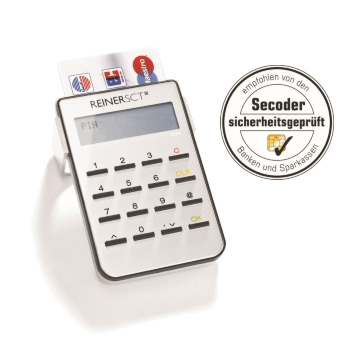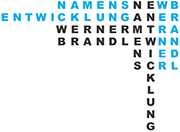FAQ and know-how on naming and branding strategies
What are the functions of brand names and trademarks?
In the lifetime of a product, there are many variables that can change: The content changes, the packaging is modernized, range structures are adjusted. One thing, however, does not change: the brand name. Why you usually do not want to change the brand name and your naming strategy becomes clear when you consider its main functions.
The brand name reflects the unique character of a product or a company. It defines their identity and it makes them inimitable. A good brand name evokes the right evocations and emotions. It builds trust in the values of a product, and it guarantees its quality.
A good example is the name Secoder, announcing security and intelligent coding methods integrated in its name: A carefully selected brand name gives you a significant competitive edge: It enables effective recognition, a clear expression of the positioning, and it allows legal protection against copyists. Thus, brand names are among the best investments of a company. It pays off to develop a brand with utmost care.
A carefully selected brand name gives you a significant competitive edge: It enables effective recognition, a clear expression of the positioning, and it allows legal protection against copyists. Thus, brand names are among the best investments of a company. It pays off to develop a brand with utmost care.
In its ideal shape, a brand is beneficent for companies just as for consumers. But the brand value is yours.
What are the benefits of a systematic naming architecture?
With diversified portfolios, it makes sense to structure the product groups or business units via clear linguistic patterns. The trick is a structure with a sense of proportion - not structure for its own sake. With a clearly defined goal and reproducible, long-term benefits as a result. This mean
 s in practice, not every single unit in a portfolio receives an isolated name, but the brand names, e.g. within a product group, are linked linguistically. They follow a consistent naming strategy. This relationship can be established through recurring semantic or morphological patterns.
s in practice, not every single unit in a portfolio receives an isolated name, but the brand names, e.g. within a product group, are linked linguistically. They follow a consistent naming strategy. This relationship can be established through recurring semantic or morphological patterns.However, the best way to discuss all this is a meeting based on specific examples of best cases along the lines of your specific project conditions.
Which challenges, dangers, and obstacles loom in naming?
For new brand names, there are three major challenges: language, marketing, and IP issues.
Linguistics
If you're unlucky, or simply negligent, names can evoke negative connotations. For example, because your brand name unintentionally resembles a word connoted as negative in a foreign language. Popular blunders are closeness to dirty words or terms for the genitals or excretions. In the past, there have been some cases causing unintended eyebrow-raising and leading to poor corporate image projection.
Marketing
Bland and colorless names are in danger of being confused with others on the market. Such names are a good way to dilute and lose your profile. Of course, this can be compensated by higher advertising expenses, thus annihilating your competitors on top. However, a distinctive identity-bearing brand name is more effective, and cheaper. A clear exception to this rule are, of course, me-too projects. They reflect a different marketing track because they are based on analogy (and not differentiation)!
IP and Trademark Law
IP and Trademark Law
Literally millions of brand names are registered as trademarks. And, to make it a little harder, there are multiple numbers of similar brands for each new brand. And many words cannot be registered because of trademark rules: they are too descriptive. It requires experience to find and select the right name.
You need not fear any of the hardships mentioned - we tame them.
Together with our partners.
Period.

What are the key naming glossary terms?
Does the world need another fancy glossary on names, branding and trademarks? Of course, no!
Therefore, here you will not find definitions from Wikipedia or some super linguist, but my personal explanations. You will find these only here, and this restriction makes sense - they are mercilessly subjective:
Abbreviation
Something long feels too long. It is tiresome and takes too much space away, so something is cut off, to make it shorter. You can see this in practice with “e.g.,” for example. Whether it will be easily understood is uncertain, especially at first encounter.
Acronym
The initial letters of a chain of words are used to form a new word that can be pronounced easily (hopefully) -- quite a simple mechanism. Very popular in politics and in the public sector. The German prime example is ELSTER tax software, which subtly suggests the topos of the “thieving magpie.”
Alliteration
Alliteration as an attention and attraction agent -- one of many apparatuses for appealing to your audience.
Alpha-Numeric
The alphabet and the empire of numbers intermingled. Codes of different sources combined. Very popular and handy with product designators such as CT3000 or A40 or M2400 PT 16. Often used as a base for structuring portfolios and name systems.
Blend
Two terms are blended into each other -- the bronze among words. For example, "Froop" is quite simple to decipher, built from “fruit” and “loop.” Which takes us to etymology, a field overrated by analysts and science. Why? Because it is irrelevant for most audiences. For most people, it’s the effect that counts.
Brand
The qualities that define a company or product in the mind of the customer.
Branding
The attempt, no matter which creative means employed, to mark a thing, a company or service so that the (paying) world recognizes it as different from the competition.
Brand Name
The wordly part of a brand, e.g., first and last name, as in Mercedes-Benz. But a brand features more dimensions than the words, like feelings, the image of a star, promises, or even sounds. And, of course, a product experience.
Brand Strategy
The concept behind a brand -– what it stands for, what it communicates, who it appeals to, which direction it should develop. More or less a plan, instruction and vision in one.
Claim
German term. Totally different from the slogan, but often used synonymously. A claim is slightly more dependent on fashion, time and temporary marketing strategy than a slogan.
Class of Goods
A trademark can only be registered for specific usage -- defined things and services. Thus, the same brand name can legally be used in entirely different fields. Various owners can possess the same word as a trademark for diverse applications. That’s why it is extremely useful to have 45 classes of goods.
Coinage
Has never appeared in the world before and therefore had to be synthesized from scratch. Take names like “Ixo,” “Evonik” or “Arvato.” A truly subjective category when it comes to tone and effect. Does a perfect job as an empty vessel for a new brand, where you want no starting content or meaning.
Derivation
An existing term, as you can find it in the dictionary, is altered slightly, e.g., by adding an extra letter. This transforms something known into something uncommon and novel. Accordingly, a series of Acer tablet computers was not named “Icon,” but “Iconia.”
Description
To describe in a factual and clear fashion how or what something is. So “boneyard” is surely more descriptive than “cemetery” -- which is still strongly descriptive for a place where dead people are buried. Another example is “fruit yogurt“ -- no matter how much real fruit the yogurt may contain. Can quickly become euphemism.
Differentiation
Being different from others. Often times not so easy, because there are quite a few of us on this earth -- and our goals are scarily uniform. For products just as valid as for enterprises or for people.
Etymology
Where a name comes from. Take BMW -- you can derive it from the term “Bayerische Motoren Werke.” As you can easily see, this category is mainly of scientific interest. Consumers typically do not analyze names too scrupulously. Often, you can also observe a divergence between real etymology (actual truth) and human imagination (perceived truth). For example, folk etymology explains German bockbier different from a historian. Now, who’s right, and who’s relevant?
Euphemism
The whole world (and above all the American one) is full of it. Its underlying principle is simple: You call and name something so that it sounds nicer and less offensive than what it actually is. In a way, you widen the already large taboo zone. Examples include "wash one’s hands" for "go to the toilet" or "odor" for "smell". A more recent example is "alternative truth".
Euphony
To some degree subjective, but, believe it or not, objectively provable criterion of being perceived as pleasant sounding. For names, often relevant.
Family Name
Pertains to products as much as to people. There are members of a family, and they carry one identical name. Well, except for patchwork families, non-conformist families and patchwork portfolios. A surprisingly obvious analogy.
Figurative Mark
An image protected as a trademark - often also referred to as a "logo."
Figurative Mark with Words
Combination of an image and a name, which is protected as a unity. Take the written Coca-Cola name with its special design; for example.
Foreign Word
A word from a foreign language is deemed interesting and relevant, and therefore it is integrated into your own language. Still, it is not familiar to most people, such as “sequel” or
"facility manager" in German. "Manager", on the other hand, has the homey status of a familiar loan word.
Generic
Familiar to most of us via its origin in the drug shelf. In a more common meaning, the general category for things, just like "car" or "hydro-dynamic generator."
Hypernym
Simply the superordinate term for a more specific word. For instance, “bird” is the hypernym for “blue jay,” or “dairy product” is one for “hearty yogurt snack with a Mediterranean aura.”
Icon
Frequently confused with “symbol.” In general, an image that signifies something and can be related to the indicated real world phenomenon by any commonly gifted person, e.g., a depiction of flames represents fire.
Loan Word
A word is taken from its home language and used in a different one. In a way, it is taken out of a family and adopted by another one. The new family treats it like their own flesh and blood. In German, people are crazy for adopted English kids. “Ticket,” “flatrate” and “primetime” all tell this story. 100 years ago, it was French kids that people endeared. The canapé still gives testimony of it. And in 100 years … ? Americans do not adopt kids so freely, and when they do, they choose rather extravagant ones from German, like “Schadenfreude” and “Angst.”
Marketing
It’s mainly about selling what and how. But not the selling itself. And if you have got nothing to sell, it’s about what you have to do to create something you can sell.
Market Research
Can help you find out what other people think of the ideas you deem great.
Marketing Strategy
Your plan for what you sell, how and where you sell it and at what price.
Metaphor
Your contention that one thing is similar to another one.
Our new margarine is as light as a cloud and has a fluffy texture –- so let’s call it “cloud.”
Metonymy
You contend that one thing can be called by the name of another thing because they have a significant relation. For example: wine glass set is named “Vina.”
Modern
Very opaque attribute. In a sense, the English word for “timely.” The German Duden defines “modern” as “reflecting the state of the art in historical, cultural, technical development.” Practically used most of the time when a manufacturer or producer cannot really specify what is positive and differentiating about their new product.
Name
What a thing, an organization, a living being or something else is called. Helps identify and differentiate from others that are similar.
Naming
To find a new/different/better name for something that has no/a bad name. Often hard work, and an indispensable base for branding.
Neologism
A newly created word. Such as “sprinko,” “elaanika” or “sprint spoon.” Naturally, an essential tool for new trademarks.
Onomastics
This term has some strange odor to it. It’s sad that no euphonic candidate could be chosen for the science of names.
Phonetics
The science of the sounds in spoken language. For names, quite relevant.
Product Group
Similar to a family of products, but with a looser relationship.
Pronunciation
The name of a person, a place or a product –- but not the generic term. Often a simple and satisfying choice to mark a company or a brand. For example, the keyboard brand Cherry got its name from the last name of its founder. With Apple, it’s different ;-)
Proper Name
You contend that one thing can be called by the name of another thing because they have a significant relation. For example: wine glass set is named “Vina.”
Rhyme
A prime and sublime quality of words and lifetime pastime for poets. But take care not to commit the crime of overused rhyme.
Second Name
Most people bear one, synonymous with “family name,” “last name” and “surname.” In countries like Korea, where some family names are incredibly common (e.g., “Park”), it can be quite a monotonous affair and for this reason doesn’t make sense for company names. In other countries, the phenomenon appears in quite a variety -- which makes it a company name option. Bahlsen, Ritter, Opel or Philip Morris give evidence.
Semantics
Important branch of linguistics relating to the content and meaning of a word. Unfortunately, a term used incorrectly terribly often. Outstanding relevance for naming.
Similarity
Of importance mainly in two dimensions: Is a name similar to an existing name? Is it similar to a trademark owned by a competitor? Similarity can result in conflicts.
Slogan
Totally different from a phenomenon called “claim” in Germany. However, often used synonymously. A tiny bit less dependent on fashion, time and temporary marketing strategy than a claim. Therefore, blessed with a slightly higher life expectancy.
Sound
What something sounds like. Not related to the content of a word. The most important concepts are, of course, euphony and its opposite. Can be proven and explained objectively.
Symbol
Often confused with icon. Something, e.g., a picture, signifies a content that is not linked with it in any physical way. A classic example is the owl standing for wisdom - this association is purely cultural.
Synonym
You replace a term with another one, and still people understand you in the way you intended. "Have you got an aspirin?" "Sure, here’s your painkiller." Which takes us to "generic" again …
Tagline
What Germans refer to as “slogan” and “claim” is mainly called “tagline” in German’s favorite donor language.
Toponym
Very popular, especially in the olden times, to christen companies. The principle is brutally simple. You take a place name, preferably from somewhere near you, and that’s it. Some examples from the old and the new world: Oerlikon Corporation, Stadtwerke Wien or, for the aficionados of American railroad watches, Waltham and Illinois and Burlington.
Trademark
A sign (word, image, shape, scent, sound …) with a special protection, the use of which for certain goods you can forbid others. Hampers the others and lets you roam freely.
Trademark Law
A field in law dealing with brands. Pertains to the realm of IP (which is an established hypernym to trademark law, by the way). A sign (word, image, shape, scent, sound …) with a special protection, the use of which for certain goods you can forbid others. Hampers the others and lets you roam free.
Trademark Register
Somewhere, all those trademarks must be recorded -- and here the trademark register comes into play. It contains all the precious information about trademarks: owner, classes, status, etc.
USP
Unique selling proposition. Ultimately, the (actual or contended) unique facet of an offer. Always a good base upon which to build a brand and find a name for it.
Verbal Branding
All words and texts related to a brand, which influence the appearance and perception of the brand.
Word Mark
The Cadillac of trademarks – it doesn’t get any better than this. You now have a monopoly on the use of the word (or phrase) in the specified classes -- and will keep it forever (as long as you renew).
The glossary is written by myself, like all textual content of the website. Copying, etc. is not permitted and is subject to prosecution.

